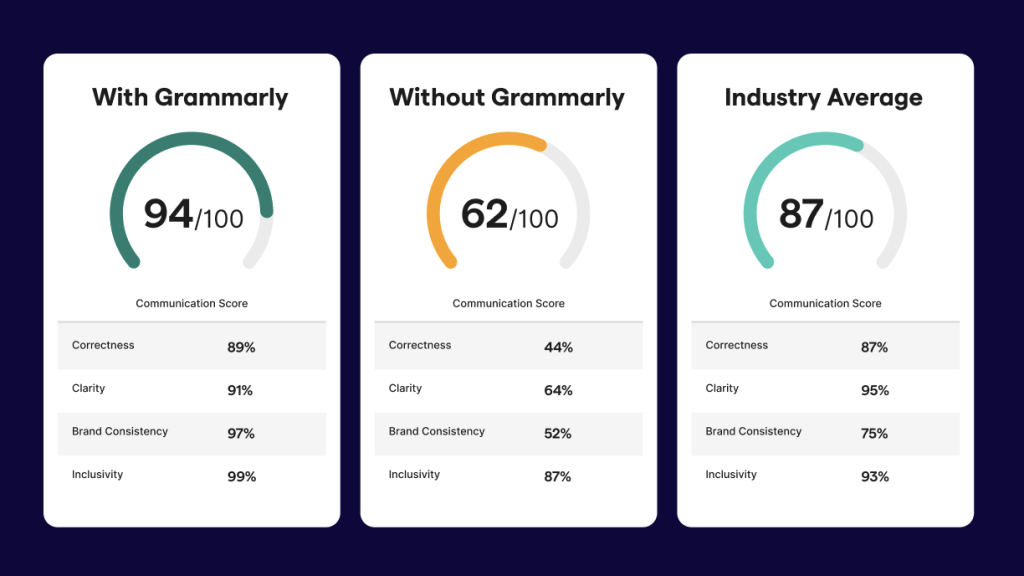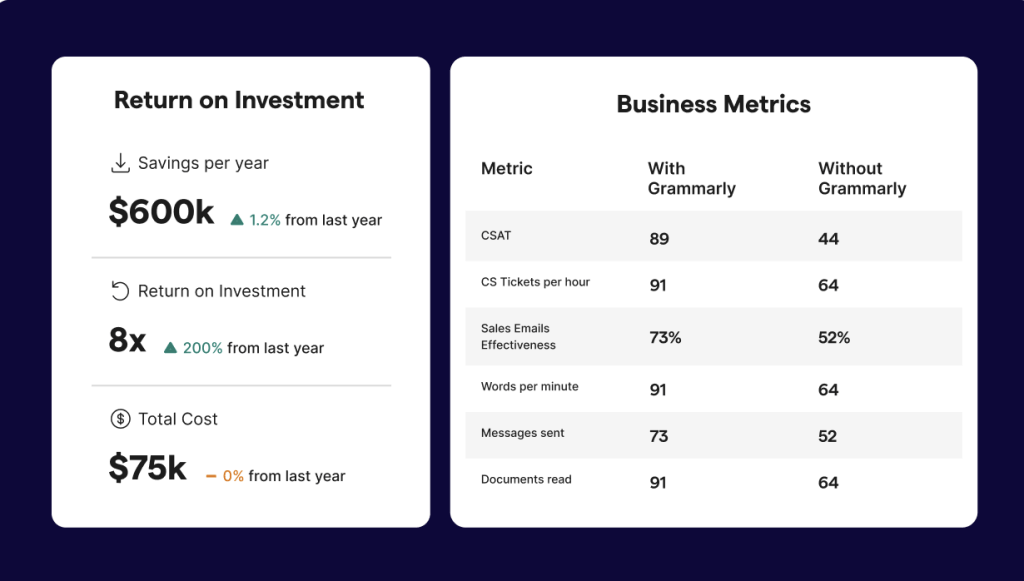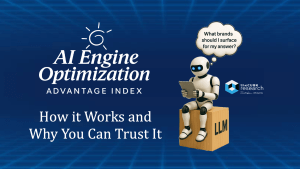Grammarly’s enterprise ROI tools, which I’ve covered here before, are now generally available. This is significant and comes at a time when organizations are increasingly scrutinizing their AI investments and seeking tangible evidence of business impact that, in many instances is incredibly difficult to measure.
I had the opportunity to sit down with Luke Behnke, Head of Product for Grammarly, to talk about the challenges organizations face quantifying the impact AI tools have on business outcomes. Watch the full interview here:
Grammarly’s Enterprise ROI Tools: Two Powerful Tools for Measuring Communication Impact
Grammarly’s release includes two key offerings: the Effective Communication Score and the Grammarly Impact Assessment with ROI reporting. The Effective Communication Score, which has been in beta testing with several dozen customers, became fully available to all enterprise customers on January 31st. This innovative scoring system allows organizations to benchmark their communication effectiveness against industry peers and track improvements across multiple dimensions including clarity, correctness, brand consistency, and inclusive language use.
The Effective Communication Score evaluates several key dimensions and provides an overall rating based on:
- How accurately the message conveys its intended meaning
- The conciseness and understandability of the content
- How well the writing aligns with established brand voice and messaging guidelines
- Compliance with the organization’s standards for inclusive language and communication

Going beyond basic metrics, Grammarly’s ROI Report enables businesses to create tailored analyses showing how the platform impacts their most important performance indicators. This customization capability is essential, allowing companies to directly connect Grammarly’s benefits to their strategic objectives. Organizations can measure Grammarly’s effectiveness through various methods, such as comparing performance between support agents who use the tool versus those who don’t, measuring email campaign results with and without Grammarly assistance, and tracking changes in customer satisfaction scores. The ROI Report’s focus on these measurable business outcomes helps organizations quantify the concrete value of their investment in AI writing technology, providing the kind of tangible evidence that decision-makers need to justify technology adoption.

And, for customers not quite ready to take the leap, Grammarly’s complementary Impact Assessment and ROI Reporting capability is perhaps one of the smartest moves I’ve seen on the part of the Grammarly team. It doesn’t just talk the talk, it walks the walk by enabling prospective customers to conduct comprehensive A/B testing and actually see for themselves concrete evidence of Grammarly’s impact on key business metrics before making a significant investment.
Getting to the ROI of Enterprise AI — What Organizations Stand to Gain
Why does this matter? That’s a no-brainer. In fact, I believe the importance of understanding how to measure and scale the value of AI initiatives can’t be overstated, especially at a time when organizations are stealing budget dollars from other places within the organization to fund AI initiatives. Being able to quantify the impact of an enterprise AI investment is more important now than ever before. The benefits of getting to the ROI of enterprise AI are multi-faceted. They include:
- The ability to realize immediate productivity gains across the enterprise by effectively deploying AI solutions that enhance existing workflows and processes, leading to measurable efficiency improvements.
- The ability to implement rigorous ROI assessment frameworks that allow them to quickly identify successful AI initiatives and scale them while terminating or pivoting away from underperforming projects, ensuring optimal resource allocation.
- Making it possible to leverage data and insights gathered from successful early AI implementations to identify and pursue more ambitious, transformative opportunities that can fundamentally reshape their business operations and competitive position.
- Secure greater investment and stakeholder buy-in by demonstrating concrete results and clear value creation, enabling them to accelerate the deployment and impact of promising AI initiatives across the organization.
I would be remiss not to mention here the success Databricks has had with Grammarly. The implementation across Databricks’ 6,000-plus organization has yielded significant results, with the company’s editorial team reporting they were able to cut editing cycle times by 50%, saving an average of 15 minutes per document. The Databricks’ customer support team improved time to resolution by 25% and increased case closure rates by 10-15%. Overall, Databricks estimates annual savings of approximately $1.4 million through their Grammarly implementation. That’s no small number.
Grammarly’s Enterprise ROI Tools’ Real-World Results Demonstrate Significant Impact
Early implementations of Grammarly’s enterprise ROI tools have shown impressive results. Customer support teams using Grammarly have seen customer satisfaction scores increase by 16-20% compared to control groups. The platform has also demonstrated a 35% reduction in copy-and-paste actions, indicating improved workflow efficiency. For teams with non-native English speakers, the impact has been particularly notable, with measurable improvements in response times and communication clarity, which are particularly helpful in contact center operations.
Setting New Standards for AI ROI Measurement
What sets Grammarly’s approach apart to enterprise AI ROI measurement is its commitment to demonstrable results. As Behnke explained in our conversation, “We believe strongly it’s on us as a vendor to help prove that case, not just because it’s good for business, but because we want people to be happy with the tool, we want them to see and understand the value.”
The platform’s ability to measure impact across various metrics — from customer satisfaction scores to first reply times and email engagement rates — provides organizations with comprehensive insights into their return on investment.
Looking Ahead: The Future of AI Communication Tools
Grammarly’s recent acquisition of Coda positions the company to move beyond its AI-powered communication solution to other enterprise offerings. The combination of Grammarly’s communication expertise with Coda’s productivity suite suggests a future where AI agents can handle increasingly complex workplace communication tasks autonomously.
For enterprise leaders evaluating AI investments, Grammarly’s enterprise AI ROI measurement tools are worth taking a look at. They provide a framework for understanding and quantifying the impact of AI-powered comms-toos. As organizations continue to navigate the complexities of remote and hybrid work environments, where written communication plays an increasingly crucial role, the ability to measure and optimize communication effectiveness becomes increasingly valuable. In fact, for a decision-maker or internal team recommending an enterprise instance of Grammarly, this would be exactly how I would prove the efficacy of the budget spend.
And in the FWIW category, Apple’s Writing tool doesn’t do this. Google Gemini doesn’t do this, and Microsoft Copilot absolutely doesn’t come anywhere close to doing this. And that, my friends, is a differentiator worth paying attention to.
The general availability of Grammarly’s enterprise AI ROI tools is good news for Grammarly’s enterprise customers. It represents a significant leap forward in enterprise AI adoption, offering organizations the ability to make data-driven decisions about their communication technology investments and illustrate the concrete benefits these tools bring to their operations. Get more information on Grammarly’s new Effective Communication Score and ROI Report here.
See more of my coverage here:
Grammarly’s Acquisition of Coda is a Strategic Pivot
Grammarly’s New ROI Tools: A Game-Changer for AI Measurement in Enterprise Communication
Grammarly’s Enterprise Features Make Deploying Gen AI Secure, Easy, and a No-Brainer



